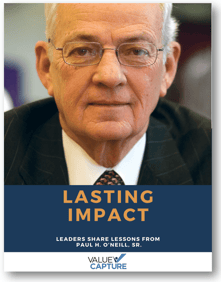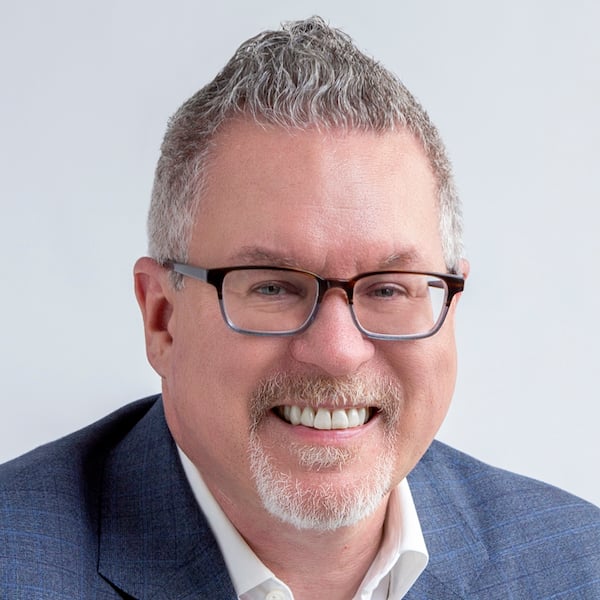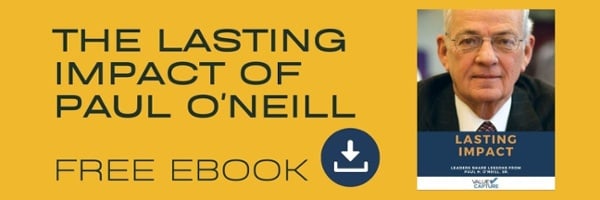Value Capture is pleased to share another excerpt, our fifth (and final), from the free eBook, Lasting Impact: Leaders Share Lessons from Paul H. O'Neill, Sr. Today, we focus on the need to lead like Paul led and the lasting impression he left on others.

The leadership lessons that he taught are timeless. And our latest book, written by George Taninecz, is a collection of stories and reflections from leaders who learned from Mr. Paul H. O'Neill, Sr. The book shows how these leadership practices and mindsets live on and will continue to be taught and passed on to others.
We hope that you'll download the book. Feel free to share it with others. See all book excerpts.
Excerpt:
Lead as O’Neill Led
It’s clear why executives who knew O’Neill are compelled to lead as their colleague, mentor, and friend would have led: replicating his approach based on theoretical limits (e.g., zero harm); grasping the moral requirements of leadership and having the courage to accept that responsibility; understanding and applying respect to everyone in multiple ways; aspiring all with whom they interact to great things; seeking out facts and data with a never-ending desire to learn; and holding firm to unshakeable beliefs and values.
“I learned so much about leadership styles from watching him, both at Alcoa, but more on the board [of Catalysis] about how you accelerate the pace of change,” says [Maureen] Bisognano.
“How do you create a culture of trust that respects every single employee in the organization? His focus on equity was always fascinating to me. If they were going to give a bonus, everybody got the same bonus. If they were going to implement a benefit, everybody got the benefit. The people at the top didn’t get a different set of benefits. That sense of equity and impatience really taught me a lot about being an effective leader.”
Legacy Health has been working with Value Capture to implement a business operating system, notes its CEO [Kathryn] Correia. “Of course, with COVID now, we’re doing everything virtually. If it was hard before, it’s so much harder now. But it’s sort of like, well, do you just kind of throw in the towel for today? I have Mr. O’Neill’s quote about choosing excellence in my office: “... if we are successful, it’s not because of CEO cheerleading... it will be because the individuals at this company have agreed to become part of something important: they’ve dedicated themselves to creating a habit of excellence.”
She says the quote inspires her, such as giving guidance on daily team huddles. “If I don’t demonstrate my commitment to excellence, nobody else needs to. I will have given permission to everyone. So, yeah, it’s frequently in my mind: What am I doing today that will help everyone I come in contact with feel positive and improve something for tomorrow? My behavior is the Number 1 way I can do that.”
Correia has been involved with lean transformations at four healthcare systems, and says they’re always about culture and understanding “the DNA, the soul of the organization” in order to help the organizations reach their full potential. What’s been different at Legacy Health with the assistance of Value Capture has been the striving for safety as a precondition. “The idea of safety just resonated with the organization, and the commitment that Value Capture made to making that always front and center demonstrated the consistency and that clear vision that I saw in Paul O’Neill... I don’t think I’ve ever seen another organization with their values on an everyday basis [like] Value Capture.”
“He was very antidependency,” says [Ken] Segel. “In fact, there were people that wanted to be dependent on Paul. At some points, we all wanted to because he cast such a powerful wake behind him. He wasn’t going to have it. He was not going to let you ask him, ‘Hey, Paul, what do we do, what’s the answer?’ In his view, that was managing up. His point was we all had responsibility to try to apply principles-driven leadership; to act from integrity; to act from facts; to act from a belief that people wanted to do great things, that they aspired to do great things; and that bad things — if God or the laws of physics do not force them to happen — then they do not need to happen, and great things could be accomplished. That was all of our work. Once I realized that and the humanity of that, it was empowering and also in some ways added to the challenge because I had a lot of work to do to measure up and try to make a contribution.”
Segel says he tries to measure up by asking himself, “What did I learn? What do I know a great leader does? What am I doing?” He then identifies the gap; in fact, he leads by knowing there will be a gap. He’s aligned his leadership to that of O’Neill’s in “advancing the same principles and possibilities in the same domain of American life that he targeted so highly in the last two decades of his life.” As a leader, Segel understands that he’s responsible for presenting a framework “that is rooted in values, rooted in integrity, and is rooted in aspiration and ways to improve together. Then people will apply that to their own work and move forward together. I have tried to empower a small but mighty organization of unbelievably talented people who want to live and work that way. In my case it’s easy because in our group, everybody is so talented, so experienced, and so smart that I couldn’t possibly tell them what to do.”
When [Bill] O’Rourke was assigned to lead Alcoa Russia, which had come about due to acquisitions, he faced two manufacturing plants where “everything was broken, everything needed to be fixed. The plants were very neglected; nothing was right. It doesn’t make you feel very good.” Flying to Russia to start his assignment and not knowing the language, culture, or people, he fully sensed the challenge that awaited. “Where in the world do you start? I had Paul as a leader. Where did he start? He started with safety... That resonated with me on the way to Russia. If we get safety right, maybe we can get everything right. So I did that. I led with safety. We trained 8,000 people the first year in safety, 6,000 a year later. I put in programs to put people in protective equipment because they had nothing... We made safety the lead, which was special. The first full calendar year that Alcoa was in Russia, there were no fatalities. They averaged five fatalities a year for 50 years in the eastern manufacturing plants. That first full year that we were there, there were none. They’ve gone eight years now in that facility without a fatality, which I think is wonderful.”
From O’Neill, [James] Anderson witnessed how “to think through what really matters, don’t stray off the course, don’t get confused by conventional thinking, and be courageous in pursuing what really matters.” That was already the direction that Anderson was headed, but O’Neill made him bolder. Honest, frank conversations with O’Neill about issues, such as employee safety, helped to validate similar efforts that he’d gotten underway at Cincinnati Children’s and “upped our courage to blaze the trail in healthcare... Being able to have that conversation with Paul let me set a goal that we could be at least as safe as a smelter.”
Eventually, Cincinnati Children’s reached a safety goal similar to what Alcoa was achieving, and, says Anderson, “I remember teasing him when we finally got to his number. We were the only hospital in the country that low. I was enormously proud of it. And he had kind of a sweet little grin that said, ‘Well, of course, you should be there.’ I thought he clearly took great pleasure in our attaining goals of great importance in addition to his having attained those goals. There was never a competitive sense. It was always a ‘That’s great, keep going, how can I help’ reaction to the achievements we were able to achieve.”
“He was a terrific mentor, which I very much appreciated,” says Anderson. “He was helpful. If he hadn’t been there, would we have done it? I think the answer is, ‘yes,’ we would have. But it would have been probably slower, less courageous, less good. And because he was there, it helped me sell some fairly radical ideas. His being there shared the responsibility for embracing radical change. I appreciate that sharing because there were times it was a fairly lonesome pathway. Having Paul there as a sidekick through this was comforting.”
When [Cliff] Orme was CEO at LifeCare Hospitals in Pittsburgh, the healthcare system embraced zero harm, and O’Neill was invited to speak to medical staff, specifically about how to reduce illegible physician orders to zero because, as O’Neill explained,
“It’s not fair for the doctor to not communicate in a concise, legible, clear way. It’s not a sign of respect for your colleagues, respect for the nurses, respect for the unit secretaries, respect for your patients, respect for yourself. And you can do better.’ There were a few physicians in that room who took his message to heart, and I was able to carry the ball with his help and with the help of Value Capture to reduce illegible medication errors to near zero levels in 90 days.”
Today, learning from O’Neill and those with whom O’Neill worked has altered Orme’s leadership of International Health Corporation. “My day has completely changed. I start my day with my team reviewing the daily safety report. We look at the incident as a team, we review the A3, which is the system that we have that Value Capture taught me on how to solve problems to root cause. I realize that my job is to be the architect of a system that allows for the reporting and solving of every problem, every situation, every incident, everything gone wrong. That was a teaching that I didn’t have prior to that time. If there was a problem, we may get around to reviewing and looking for a solution within a month or two or maybe a quarter — but sometimes looking backward to solve problems that happened a year ago.
What I learned from Value Capture and Paul was to take everything gone wrong and solve it in real time. It’s possible.”
Orme says the potential is great for every employee in the organization to report many problems in a single shift that need solved as quickly as possible; without knowing the problem, there is no solving the problem. “So I encourage and reward people for identifying problems. That was a shift in my way of thinking as a business leader, as a hospital leader, that I never had prior to Paul. And I could never run the hospital the same way after talking and working with Value Capture and Paul.”
Dr. [Steven] Muething, in addition to his work at Cincinnati Children’s, helped to establish Solutions for Patient Safety, a learning network for children’s hospitals that today consists of leaders from more than 140 hospitals whose goal is to create a universally safe and healing environment for all children in their care. When he was getting the organization up and running, initially in Ohio with six hospitals, he met O’Neill. The network advocated for changes such as zero harm; data sharing openly, transparently, and honestly; and CEOs driving the work instead of quality leaders who were not in place or even considered. O’Neill was an ally and agitator as the organization grew.
“About five years ago or so when I relied on him the most, he was pushing me in his typical Paul O’Neill way: ‘Why aren’t we looking at employee safety? Why are we only looking at patient safety? How much harm is happening to employees at the same time it’s happened to all these patients?’ He really pushed me in the role I had as leader to take on employee safety at the same time we were doing patient safety, which we had already done at Cincinnati Children’s. But to do that on a national scale with all the children’s hospitals was a huge step forward.”
From O’Neill’s prodding, Solutions for Patient Safety organized a two-day summit in Pittsburgh, involving approximately 60 children’s hospitals, a dozen CEOs, and hundreds of employees. “We used that as a leverage point to adopt zero harm for employees, just like we had adopted zero harm for patients. And it’s continuing to this day. Now we’re all sharing all our employee safety data at the same time we’re sharing all of our patient safety data... Maybe it would have happened without his mentorship, advice, and push, but it certainly wouldn’t have happened as soon as or as effectively as it did with his push and help.”
Lasting Impressions
With so many accomplishments in O’Neill’s life, it’s difficult to point to a most important contribution, which simply illustrates the breadth of his influence. Many achievements, both business and personal, were mentioned by his colleagues, friends, and mentees — deep respect for people and safety as the ultimate show of respect; leadership and objectives consistent with core values and beliefs; an unwavering intent to do the right thing; and an unremitting pursuit of improved healthcare safety and quality of care.
Bisognano says that she loved the fact that O’Neill would often talk about his family and, as a great leader, was also a normal person. “It wasn’t like when he walked into work, he shed everything and became a different person. He was a fully engaged human being every single day of his life.” Knowing him, she adds, was a wonderful experience. “He really is the definition, for me, of a truly revolutionary leader.”
What stands out about O’Neill for Dr. Muething is that “seeing that leadership, and what you’re trying to achieve, is not separate from your core values and your beliefs in the world and how it should be approached. You can’t serve as a leader with one set of values and serve as a human with a different set of values. A leader has to get clear on what their values are, and then you’ve got to lead that way, you’ve got to serve that way every day. I think somewhere along the line, he got that clear in his head, and he decided that’s the way he was going to live his life. That’s the kind of leader he was going to be. That was all one and the same.”
“Paul definitely had a vision of how to make the world a better place and how to do that from a values-based framework in the pursuit of excellence, in a way that engaged and unleashed every single person’s fullest potential, working together to continuously improve and learn,” says [Vickie] Pisowicz. “I think he did that in different ways throughout his career, from the very beginning, through Alcoa, through the Treasury, and through his work in healthcare and education.” She adds that what best embodies O’Neill’s passion and his view on leadership was his unwavering pursuit of worker safety and zero injuries in any industry or work. It was the first and only starting point for him.
"Even if you don’t understand the total package, the starting point for anyone on that journey is working together, learning and sharing in real time, and employing our most creative thinking and innovative ideas to keep each other safe. In that way, for me, he embodied the theoretical limit of values-based leadership and humanity.”
[Kevin] McKnight says O’Neill will be remembered “first of all for the criticality of safety as the ultimate respect for the individual and, secondly, his enormous contributions to improvements in safety and efficiency in hospitals and healthcare in general. I know he cared so deeply about it, he felt so deeply that he could help and drive change. He dedicated so much effort and so much of his personal time to it.”
Yet, adds McKnight, it was never about O’Neill. Some leaders hold themselves up as being in a different class; O’Neill was not one of them. “Paul always wanted people to see him as an ordinary human, [albeit] maybe one with incredible insights, incredible drive, and an incredible sense of who he was and what he wanted to do. But what struck me so much about Paul in his life was how genuine he was and how much he was just an individual. He didn’t want to be seen as anything more than that I think...
For Paul, everybody was the same. He believed so strongly that everybody should have the same opportunities, the same respect, and the same sense of self.”
“It was wonderful to know him, and when I went to Russia I tried to emulate him,” says O’Rourke. “I hold him responsible for the success that I had. It is because he was in my life that I was able to take some of those lessons and pass them on. If you have an opportunity to use the Paul O’Neill game plan, you’re probably going to be successful always.”
“He should be remembered for demonstrating one of the largest impacts of combining the heart and intellect that we’ve seen,” says Segel. “He should be remembered for the profundity of his commitment to lead others and to show what’s possible at scale for human beings working together based on the best of human nature. He worked damn hard to put himself in a position to take on the deepest challenges in a way that he felt would validate what he believed about people and that would play a role in eliminating a lot of the profound waste that we inflict on each other as human beings, starting with failing each other at the fundamental level of dignity and respect for every individual... [He had a] boundless willingness, along with his direct leadership roles, to share and teach others these ideas and make it not about himself but about the principles and the need for each of us — for everyone — to kind of have our own internal steel or internal rigor to act on them, as he said, ‘When no one is looking.’ And I would add, when everyone is looking.”
“I think Paul should be remembered for the person that proved perfect was possible; he proved it,” says Dr. [Rick] Shannon of Duke Health. “Paul’s death has been difficult for me, much more difficult than I would have thought. It’s hard to imagine the journey forward without that little voice whispering in your ear, that resolve, that intellect, that insight, that drive, that you could see any time you were with him... I have had a really hard time. I’m not alone. I know that. I’m not the kind of person that is easily distressed by loss. But this one hurts.”
Get the Full eBook (Free PDF):

Written by Mark Graban
Mark Graban has served healthcare clients since 2005. Mark is internationally recognized as a leading author and speaker on Lean healthcare. His latest book is "The Mistakes That Make Us: Cultivating a Culture of Learning and Innovation."



Submit a comment